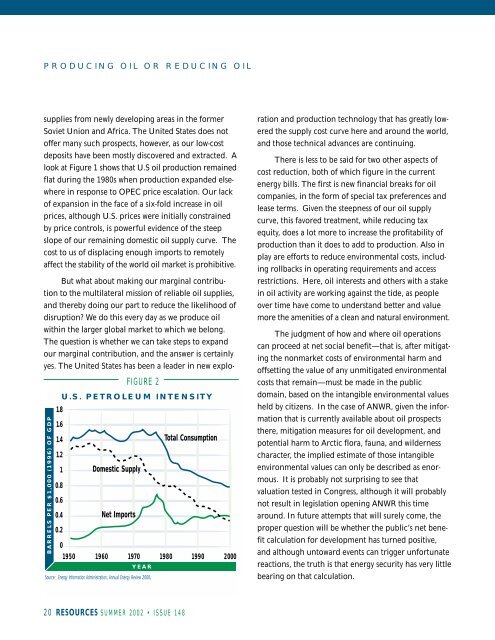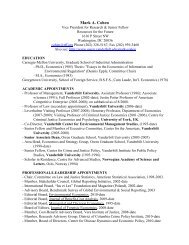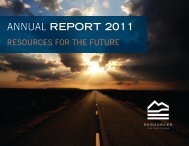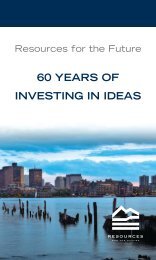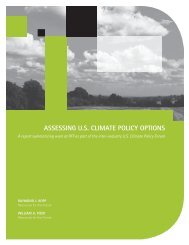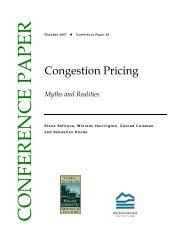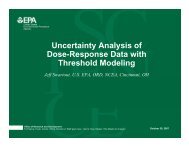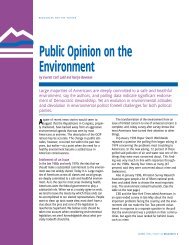Resources: Summer 2002; Issue 148 - Resources for the Future
Resources: Summer 2002; Issue 148 - Resources for the Future
Resources: Summer 2002; Issue 148 - Resources for the Future
Create successful ePaper yourself
Turn your PDF publications into a flip-book with our unique Google optimized e-Paper software.
PRODUCING OIL OR REDUCING OIL<br />
supplies from newly developing areas in <strong>the</strong> <strong>for</strong>mer<br />
Soviet Union and Africa. The United States does not<br />
offer many such prospects, however, as our low-cost<br />
deposits have been mostly discovered and extracted. A<br />
look at Figure 1 shows that U.S oil production remained<br />
flat during <strong>the</strong> 1980s when production expanded elsewhere<br />
in response to OPEC price escalation. Our lack<br />
of expansion in <strong>the</strong> face of a six-fold increase in oil<br />
prices, although U.S. prices were initially constrained<br />
by price controls, is powerful evidence of <strong>the</strong> steep<br />
slope of our remaining domestic oil supply curve. The<br />
cost to us of displacing enough imports to remotely<br />
affect <strong>the</strong> stability of <strong>the</strong> world oil market is prohibitive.<br />
BARRELS PER $1,000 (1996) OF GDP<br />
1.8<br />
1.6<br />
1.4<br />
1.2<br />
1<br />
0.8<br />
0.6<br />
0.4<br />
0.2<br />
0<br />
Domestic Supply<br />
Net Imports<br />
FIGURE 2<br />
U.S. PETROLEUM INTENSITY<br />
Total Consumption<br />
1950 1960 1970 1980 1990 2000<br />
YEAR<br />
Source: Energy In<strong>for</strong>mation Administration, Annual Energy Review 2000.<br />
But what about making our marginal contribution<br />
to <strong>the</strong> multilateral mission of reliable oil supplies,<br />
and <strong>the</strong>reby doing our part to reduce <strong>the</strong> likelihood of<br />
disruption? We do this every day as we produce oil<br />
within <strong>the</strong> larger global market to which we belong.<br />
The question is whe<strong>the</strong>r we can take steps to expand<br />
our marginal contribution, and <strong>the</strong> answer is certainly<br />
yes. The United States has been a leader in new exploration<br />
and production technology that has greatly lowered<br />
<strong>the</strong> supply cost curve here and around <strong>the</strong> world,<br />
and those technical advances are continuing.<br />
There is less to be said <strong>for</strong> two o<strong>the</strong>r aspects of<br />
cost reduction, both of which figure in <strong>the</strong> current<br />
energy bills. The first is new financial breaks <strong>for</strong> oil<br />
companies, in <strong>the</strong> <strong>for</strong>m of special tax preferences and<br />
lease terms. Given <strong>the</strong> steepness of our oil supply<br />
curve, this favored treatment, while reducing tax<br />
equity, does a lot more to increase <strong>the</strong> profitability of<br />
production than it does to add to production. Also in<br />
play are ef<strong>for</strong>ts to reduce environmental costs, including<br />
rollbacks in operating requirements and access<br />
restrictions. Here, oil interests and o<strong>the</strong>rs with a stake<br />
in oil activity are working against <strong>the</strong> tide, as people<br />
over time have come to understand better and value<br />
more <strong>the</strong> amenities of a clean and natural environment.<br />
The judgment of how and where oil operations<br />
can proceed at net social benefit—that is, after mitigating<br />
<strong>the</strong> nonmarket costs of environmental harm and<br />
offsetting <strong>the</strong> value of any unmitigated environmental<br />
costs that remain—must be made in <strong>the</strong> public<br />
domain, based on <strong>the</strong> intangible environmental values<br />
held by citizens. In <strong>the</strong> case of ANWR, given <strong>the</strong> in<strong>for</strong>mation<br />
that is currently available about oil prospects<br />
<strong>the</strong>re, mitigation measures <strong>for</strong> oil development, and<br />
potential harm to Arctic flora, fauna, and wilderness<br />
character, <strong>the</strong> implied estimate of those intangible<br />
environmental values can only be described as enormous.<br />
It is probably not surprising to see that<br />
valuation tested in Congress, although it will probably<br />
not result in legislation opening ANWR this time<br />
around. In future attempts that will surely come, <strong>the</strong><br />
proper question will be whe<strong>the</strong>r <strong>the</strong> public’s net benefit<br />
calculation <strong>for</strong> development has turned positive,<br />
and although untoward events can trigger un<strong>for</strong>tunate<br />
reactions, <strong>the</strong> truth is that energy security has very little<br />
bearing on that calculation.<br />
20 RESOURCES SUMMER <strong>2002</strong> • ISSUE <strong>148</strong>


